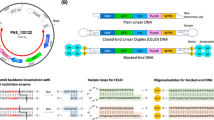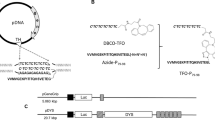Abstract
New strategies to improve the outcome of gene therapy often employ a nonviral gene delivery, which is most likely to fulfil microbiological safety criteria and be retained in the clinical setting. Here we show that efficient gene transfer can be achieved in vitro using as a vector a polyvalent peptide derived from the N-terminal sequence of the human adenovirus fiber protein. The level of transfection is better than that obtained with the two liposomes, DOTAP and DOSPER. Internalization was studied by confocal microscopy using fluorescently marked peptide and DNA. The peptide alone is targeted to the nucleus and concentrated within the nucleolus. Similarly, DNA complexed with peptide also enters the nucleolus, where it is retained for at least 48 h. Peptide I appears to attach to cells by a saturable process, as preincubation of cells with peptide blocks transfection and there is no transfection at 4°C. The peptide contains three domains: a nuclear localization signal of adenovirus fiber protein; a domain containing hydrophobic and polar residues harboring an internalization signal for receptor-mediated endocytosis; and a stretch of lysines. Each of these domains is required for optimum gene transfer. Peptide I may be an interesting alternative to known vectors for gene transfer, for local administration and for ex vivo applications.
This is a preview of subscription content, access via your institution
Access options
Subscribe to this journal
Receive 12 print issues and online access
$259.00 per year
only $21.58 per issue
Buy this article
- Purchase on Springer Link
- Instant access to full article PDF
Prices may be subject to local taxes which are calculated during checkout








Similar content being viewed by others
References
Felgner JH et al. Enhanced gene delivery and mechanism studies with a novel series of cationic lipid formulations J Biol Chem 1994 269: 2550–2561
Zabner J et al. Cellular and molecular barriers to gene transfer by a cationic lipid J Biol Chem 1995 270: 18997–20007
Fender P et al. Adenovirus dodecahedron, a new vector for human gene transfer Nature Biotech 1997 15: 52–56
Devaux C et al. Crystallization, enzymatic cleavage, and polarity of the adenovirus type 2 fiber Virology 1987 161: 121–128
Richardson WD et al. Nuclear protein migration involves two steps: rapid binding at the nuclear envelope followed by slower translocation through nuclear pores Cell 1988 52: 655–664
De Robertis EM, Longthorne RF, Gurdon JB . Intracellular migration of nuclear proteins in Xenopus oocytes Nature 1978 272: 254–256
Hong JS, Engler JA . The amino terminus of the adenovirus fiber protein encodes the nuclear localization signal Virology 1991 185: 757–767
Chen WJ, Goldstein JL, Brown MS . NPXY, a sequence often found in cytoplasmic tails, is required for coated-pit mediated internalization of the low density lipoprotein receptor J Biol Chem 1990 265: 3116–3123
Paccaud J-P et al. Clathrin-coated pit-mediated receptor internalization J Biol Chem 1993 268: 23191–23196
Hsu D et al. NPXY motif in the insulin-like growth factor-I receptor is required for efficient ligand-mediated receptor internalization and biological signaling Endocrinology 1994 134: 744–750
Li S, Huang L . In vivo gene transfer via intravenous administration of cationic lipid-protamine–DNA (LPD) complexes Gene Therapy 1997 4: 891–900
van de Lest CH et al. Quantification and characterization of glycosaminoglycans at the nanogram level by a recombined azure-silver staining in agarose gels Anal Biochem 1994 221: 356–361
Zauner W et al. Glycerol enhancement of ligand–polylysine/DNA transfection Biotechniques 1996 20: 905–913
Biggiogera M, Bigioggera FF . Ethidium bromide- and propidium iodide-PTA staining of nucleic acids at the electron microscopic level J Histochem Cytochem 1989 37: 1161–1166
Scheiffele P, Roth MG, Simons K . Interaction of influenza virus hemagglutinin with sphingolipid-cholesterol membrane domains via its transmembrane domain EMBO J 1997 16: 5501–5508
Walter A, Steer CJ, Blumenthal R . Polylysine induces pH-dependent fusion of acidic phospholipid vesicles: a model for polycation-induced fusion Biochim Biophys Acta 1986 861: 319–330
Sheldon K, Liu D, Ferguson J, Gariepy J . Loligomers: design of de novo peptide-based intracellular vesicles Proc Natl Acad Sci USA 1995 92: 2056–2060
van Klompenburg W, Nilsson IM, von Heijne G, de Kruijff B . Anionic phospholipids are determinants of membrane protein topology EMBO J 1997 16: 4261–4266
Niidome T et al. Binding of cationic a-helical peptides to plasmid DNA and their gene transfer abilities into cells J Biol Chem 1997 272: 15307–15312
Wadhwa MS et al. Peptide-mediated gene delivery: influence of peptide structure on gene expression Bioconjug Chem 1997 8: 81–88
Emi N, Kidoaki S, Yoshikawa K, Saito H . Gene transfer mediated by polyarginine requires a formation of big carrier-complexes of DNA aggregate Biochim Biophys Res Comm 1997 231: 421–424
Wagner E et al. Influenza virus hemagglutinin HA-2 N-terminal fusogenic peptides augment gene transfer by transferrin-polylysine–DNA complexes: toward a synthetic virus-like gene-transfer vehicle Proc Natl Acad Sci USA 1992 89: 7934–7938
Plank C et al. Gene transfer into hepatocytes using asialoglycoprotein receptor mediated endocytosis Bioconj Chem 1992 3: 533–539
Wilke M et al. Efficacy of a peptide-based gene delivery system depends on mitotic activity Gene Therapy 1996 3: 1133–1142
Gottschalk S et al. A novel DNA–peptide complex for efficient gene transfer and expression in mammalian cells Gene Therapy 1996 3: 448–457
Hart SL et al. Gene delivery and expression mediated by an integrin-binding peptide Gene Therapy 1995 2: 552–554
Derossi D et al. Cell internalization of the third helix of the antennapedia homeodomain is receptor-independent J Biol Chem 1966 271: 18188–18193
Vivès E, Brodin P, Lebleu B . A truncated HIV-1 Tat protein basic domain rapidly translocates through the plasma membrane and accumulates in the cell nucleus J Biol Chem 1997 272: 16010–16017
Author information
Authors and Affiliations
Rights and permissions
About this article
Cite this article
Zhang, F., Andreassen, P., Fender, P. et al. A transfecting peptide derived from adenovirus fiber protein. Gene Ther 6, 171–181 (1999). https://doi.org/10.1038/sj.gt.3300801
Received:
Accepted:
Published:
Issue Date:
DOI: https://doi.org/10.1038/sj.gt.3300801
Keywords
This article is cited by
-
The Ad5 fiber mediates nonviral gene transfer in the absence of the whole virus, utilizing a novel cell entry pathway
Gene Therapy (2005)
-
Utilization of synthetic peptides containing nuclear localization signals for nonviral gene transfer systems
Gene Therapy (2002)
-
CL22 – a novel cationic peptide for efficient transfection of mammalian cells
Gene Therapy (2001)
-
Transfection of large plasmids in primary human myoblasts
Gene Therapy (2001)
-
Cell delivery, intracellular trafficking and expression of an integrin-mediated gene transfer vector in tracheal epithelial cells
Gene Therapy (2000)



